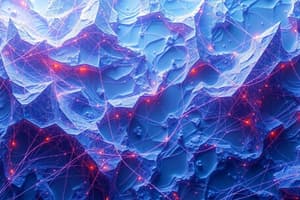Podcast
Questions and Answers
What is the primary goal of leveraging additive manufacturing (3D printing) in space exploration?
What is the primary goal of leveraging additive manufacturing (3D printing) in space exploration?
- To reduce reliance on Earth-based resupply missions. (correct)
- To increase the weight of space missions for research purposes.
- To limit the use of structural components in space habitats.
- To complicate the process of creating spare parts on celestial bodies.
What does ISRU stand for in the context of 3D printing in space?
What does ISRU stand for in the context of 3D printing in space?
- Ionospheric Sample Retrieval Uplink
- In-Situ Resource Utilization (correct)
- Integrated Structural Repair Unit
- Interstellar Space Recycling Unit
Which of the following is a key challenge related to material behavior when 3D printing in microgravity?
Which of the following is a key challenge related to material behavior when 3D printing in microgravity?
- Consistent material behavior compared to Earth-based printing.
- Enhanced convection during the printing process.
- The way molten materials, powders, and feedstock behave differently in zero gravity. (correct)
- Predictable deposition of molten materials.
Why is printer stability a significant challenge for 3D printing in space?
Why is printer stability a significant challenge for 3D printing in space?
What is a primary concern regarding the durability of 3D-printed parts in space?
What is a primary concern regarding the durability of 3D-printed parts in space?
What is the main purpose of NASA's Refabricator project?
What is the main purpose of NASA's Refabricator project?
Which material is ESA (European Space Agency) exploring for use in 3D printing lunar habitats?
Which material is ESA (European Space Agency) exploring for use in 3D printing lunar habitats?
What is a significant benefit of using lunar regolith for 3D printing on the Moon?
What is a significant benefit of using lunar regolith for 3D printing on the Moon?
Besides constructing habitats, what is another application of 3D printing being explored by ESA?
Besides constructing habitats, what is another application of 3D printing being explored by ESA?
How does 3D printing contribute to reducing mission costs in space exploration?
How does 3D printing contribute to reducing mission costs in space exploration?
How does utilizing 3D printing in space enhance mission self-sufficiency?
How does utilizing 3D printing in space enhance mission self-sufficiency?
How does 3D printing facilitate rapid prototyping and repair of critical components during space missions?
How does 3D printing facilitate rapid prototyping and repair of critical components during space missions?
What specific aspect of space environments poses a challenge to the 'Durability in Extreme Conditions' of 3D-printed components?
What specific aspect of space environments poses a challenge to the 'Durability in Extreme Conditions' of 3D-printed components?
How does surface tension affect 3D printing processes in microgravity, and why is it a significant challenge?
How does surface tension affect 3D printing processes in microgravity, and why is it a significant challenge?
Why is 'controlling material deposition' considered a significant hurdle in achieving consistent quality in 3D printing for space applications?
Why is 'controlling material deposition' considered a significant hurdle in achieving consistent quality in 3D printing for space applications?
Considering the limitations of power consumption in space missions, how does this constraint influence the design and utilization of 3D printers?
Considering the limitations of power consumption in space missions, how does this constraint influence the design and utilization of 3D printers?
How might the 'closed-loop recycling' aspect of NASA's Refabricator project address the logistical challenges of long-term space travel, particularly concerning resource management?
How might the 'closed-loop recycling' aspect of NASA's Refabricator project address the logistical challenges of long-term space travel, particularly concerning resource management?
In the context of ESA's Lunar Base projects, what are the potential implications of utilizing lunar regolith for 3D printing in relation to the long-term sustainability and economic viability of lunar settlements?
In the context of ESA's Lunar Base projects, what are the potential implications of utilizing lunar regolith for 3D printing in relation to the long-term sustainability and economic viability of lunar settlements?
Considering the challenges of 'Material Behavior in Microgravity', what innovative strategies could be employed to control material deposition and ensure consistent quality in 3D printing processes on celestial bodies with negligible gravity?
Considering the challenges of 'Material Behavior in Microgravity', what innovative strategies could be employed to control material deposition and ensure consistent quality in 3D printing processes on celestial bodies with negligible gravity?
Given the necessity for 3D printers to function in very low or no atmosphere, what specific design considerations are critical to prevent common engineering failures associated with vacuum environments?
Given the necessity for 3D printers to function in very low or no atmosphere, what specific design considerations are critical to prevent common engineering failures associated with vacuum environments?
Flashcards
3D printing focus in space exploration
3D printing focus in space exploration
Using additive manufacturing to decrease dependency on resupply missions from earth. Includes creating tools, spare parts and structural parts directly on celestial bodies.
In-Situ Resource Utilization (ISRU)
In-Situ Resource Utilization (ISRU)
Using resources found on celestial bodies like the moon or mars instead of transporting them from earth.
Material Behavior in Microgravity
Material Behavior in Microgravity
Molten materials, powders and printing feedstocks behaving differently in zero gravity.
Printer Stability in harsh space environment
Printer Stability in harsh space environment
Signup and view all the flashcards
Durability challenges
Durability challenges
Signup and view all the flashcards
NASA's Refabricator
NASA's Refabricator
Signup and view all the flashcards
ESA's Lunar Base Projects
ESA's Lunar Base Projects
Signup and view all the flashcards
3D printing applications
3D printing applications
Signup and view all the flashcards
Importance of 3D Printing in Space
Importance of 3D Printing in Space
Signup and view all the flashcards
Study Notes
Focus
- Additive manufacturing (3D printing) aims to reduce reliance on Earth-based resupply missions
- The tech creates tools, spare parts, and structural components on celestial bodies like the Moon or Mars
- In-situ resource utilization (ISRU) is vital for long-duration space missions
Key Challenges: Material Behavior in Microgravity
- Molten materials, powders, and printing feedstocks behave differently in zero gravity
- Surface tension and lack of convection affect the printing process
- Controlling material deposition and ensuring consistent quality is a significant hurdle
Key Challenges: Printer Stability
- Printers must be robust and stable in the harsh space environment
- Vibrations, temperature fluctuations, and radiation exposure can damage sensitive components
- Printers must function in very low or no atmosphere
Key Challenges: Durability in Extreme Conditions
- Space environments have extreme temperature swings, radiation, and micrometeoroid impacts
- Printed parts must withstand these conditions, remaining functional and reliable, with power consumption limitations.
Applications: NASA's Refabricator
- The project demonstrates closed-loop recycling and manufacturing in space
- It breaks down waste materials to create new tools and parts
- It is a key technology for long term space travel
Applications: ESA's Lunar Base Projects
- The European Space Agency (ESA) explores using 3D printing to construct lunar habitats and infrastructure
- Lunar regolith (soil) is a potential printing material
- Using lunar regolith drastically reduces the amount of material transported from Earth
Additional Applications
- Building spare parts on the international space station
- Creating specialized tools for specific extravehicular activities
Importance of 3D Printing
- Reduces mission costs
- Increases mission self-sufficiency
- Enables more ambitious and long-duration space missions
- Allows for rapid prototyping and repair of critical components
Studying That Suits You
Use AI to generate personalized quizzes and flashcards to suit your learning preferences.




